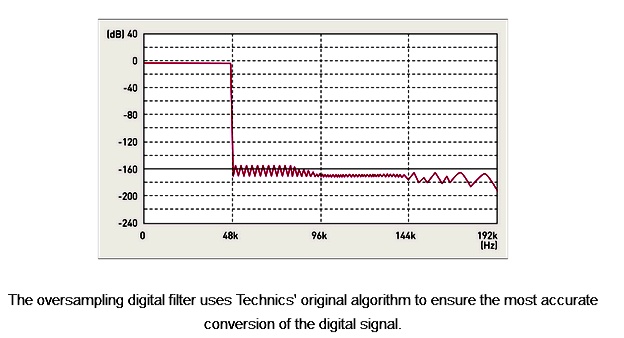Post History
The oversampling is said to simplify the LPF yet the better reason is that it improves the SNR. Lower noise comes from better image rejection, lower filter ringing, and significantly lower group d...
#3: Post edited
- The oversampling is said to simplify the LPF yet the better reason is that it improves the SNR.
Noise comes from better image rejection, lower filter ringing and significantly lower group delay distortion in the audio band as the band edge is moved up. The majority of phase shift traverses over +/-1 frequency decade from the breakpoint and group delay is the rate of change of phase shift, you can imagine that shifting the rate to 176.4 kHz eliminates the group delay distortion 1 decade down from there while providing adequate image rejection with a linear phase FIR filter.- Filter skirts only attenuate -6dB per 2f octave per order of filter thus the process of oversampling provides the greatest benefit to SNR.
- https://www.digikey.in/en/articles/why-and-how-to-use-digital-filters-for-analog-to-digital-conversions
- https://www.technics.com/uk/support/discontinued-products/premium-class/sl-c700.html
- 
- The oversampling is said to simplify the LPF yet the better reason is that it improves the SNR.
- Lower noise comes from better image rejection, lower filter ringing, and significantly lower group delay distortion in the audio band as the band edge is moved up.
- The majority of phase shift traverses over +/-1 frequency decade from the breakpoint and group delay is the rate of change of phase shift, you can imagine that shifting the rate to 176.4 kHz eliminates the group delay distortion 1 decade down from there while providing adequate image rejection with a linear phase FIR filter.
- Filter skirts only attenuate -6dB per 2f octave per order of filter thus the process of oversampling provides the greatest benefit to SNR.
- https://www.digikey.in/en/articles/why-and-how-to-use-digital-filters-for-analog-to-digital-conversions
- https://www.technics.com/uk/support/discontinued-products/premium-class/sl-c700.html
- 
#2: Post edited
- The oversampling is said to simplify the LPF yet the better reason is that it improves the SNR.
- Noise comes from better image rejection, lower filter ringing and significantly lower group delay distortion in the audio band as the band edge is moved up. The majority of phase shift traverses over +/-1 frequency decade from the breakpoint and group delay is the rate of change of phase shift, you can imagine that shifting the rate to 176.4 kHz eliminates the group delay distortion 1 decade down from there while providing adequate image rejection with a linear phase FIR filter.
- Filter skirts only attenuate -6dB per 2f octave per order of filter thus the process of oversampling provides the greatest benefit to SNR.
- https://www.digikey.in/en/articles/why-and-how-to-use-digital-filters-for-analog-to-digital-conversions
- The oversampling is said to simplify the LPF yet the better reason is that it improves the SNR.
- Noise comes from better image rejection, lower filter ringing and significantly lower group delay distortion in the audio band as the band edge is moved up. The majority of phase shift traverses over +/-1 frequency decade from the breakpoint and group delay is the rate of change of phase shift, you can imagine that shifting the rate to 176.4 kHz eliminates the group delay distortion 1 decade down from there while providing adequate image rejection with a linear phase FIR filter.
- Filter skirts only attenuate -6dB per 2f octave per order of filter thus the process of oversampling provides the greatest benefit to SNR.
- https://www.digikey.in/en/articles/why-and-how-to-use-digital-filters-for-analog-to-digital-conversions
- https://www.technics.com/uk/support/discontinued-products/premium-class/sl-c700.html
- 
#1: Initial revision
The oversampling is said to simplify the LPF yet the better reason is that it improves the SNR. Noise comes from better image rejection, lower filter ringing and significantly lower group delay distortion in the audio band as the band edge is moved up. The majority of phase shift traverses over +/-1 frequency decade from the breakpoint and group delay is the rate of change of phase shift, you can imagine that shifting the rate to 176.4 kHz eliminates the group delay distortion 1 decade down from there while providing adequate image rejection with a linear phase FIR filter. Filter skirts only attenuate -6dB per 2f octave per order of filter thus the process of oversampling provides the greatest benefit to SNR. https://www.digikey.in/en/articles/why-and-how-to-use-digital-filters-for-analog-to-digital-conversions


















